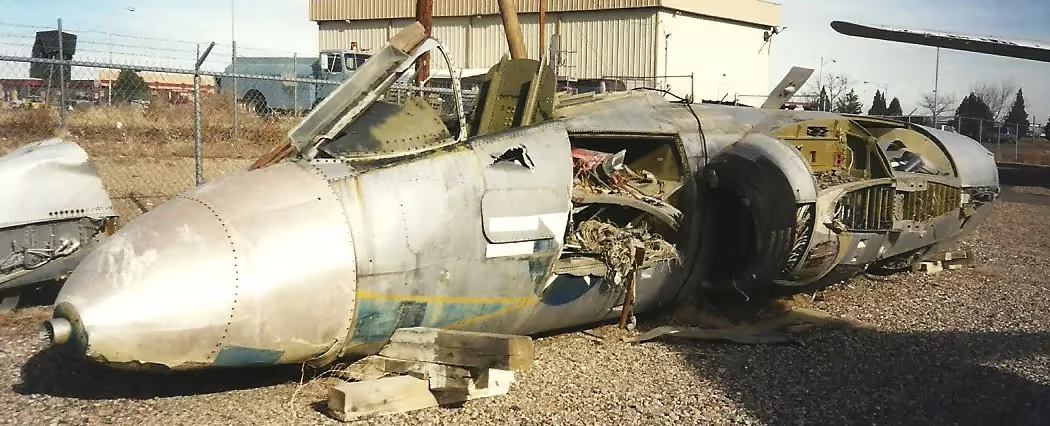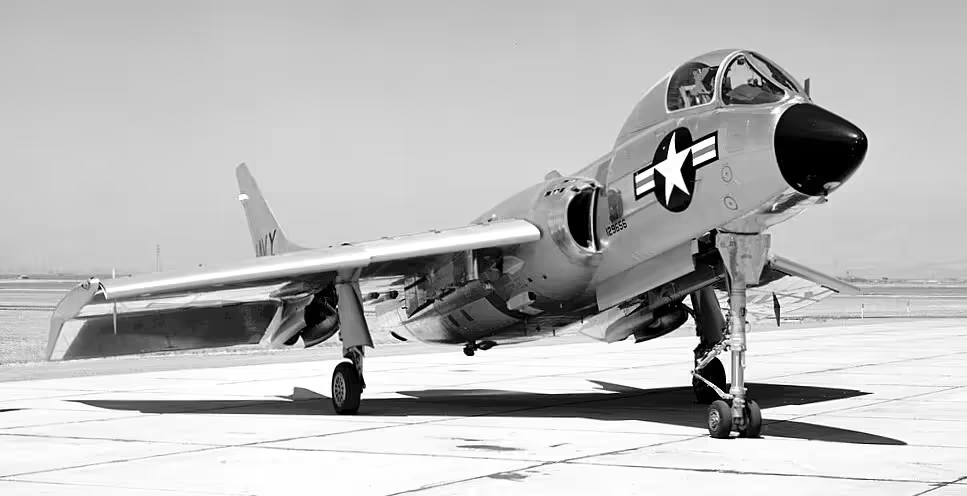Warplanes of the USA: Vought F7U Cutlass
Vought F7U Cutlass

(USN Photo)
Vought F7U-3 Cutlass (BuNo. 128464) from Air Development Squadron VX-3 out of Naval Air Station Atlantic City, New Jersey, 15 January 1954.
The Vought F7U Cutlass was a United States Navy carrier-based jet fighter and fighter-bomber designed and produced by the aircraft manufacturer Chance Vought. It was the first tailless production fighter in the United States as well as the Navy's first jet equipped with swept wings and the first to be designed with afterburners. The Cutlass was developed from the mid 1940s to early 1950s as Vought's entry in a United States Navy competition. Their design team, which was influenced by design information obtained from Nazi Germany, opted for a tailless configuration paired with low aspect ratio swept wings, which was regarded as a radical departure from traditional aircraft design for the era. Vought's submission was favoured by Navy officials and was declared the winner in 1946. On 29 September 1948, the prototype performed its maiden flight; all three prototypes would be lost during the flight test program. It was initially powered by a pair of Westinghouse J34 turbojet engines which were relatively underpowered, contributing to its accident-prone nature; its unreliable hydraulic flight control system was also a source of difficulties.
The first production model of the Cutlass, F7U-1, entered service during July 1951. It was promptly followed by F7U-2 and F7U-3, improved models that were equipped with more powerful engines amongst other refinements. However, the Cutlass continued to suffer from frequent technical and handling problems throughout the aircraft's short service career. Accidents involving the type were responsible for the deaths of four test pilots and 21 other U.S. Navy pilots.[2] Over one quarter of all Cutlasses built were destroyed in accidents; this high rate of accidents led to the type being withdrawn during the late 1950s despite having been in service for less than ten years. (Wikipedia)
In a book written by the aviation author Martin Caiden, he described a flight demonstration in a Cutlass by a pilot named Paul Thayer who was putting on an airshow display over the Patuxtent River. Caiden saw Thayer roar in low over the airfield and then watched him pull up into a vertical climb to the “cheers of thousands.” Near the top of his climb, the entire aft end of the Cutlass burst into flames, followed by Thayer ejecting safely to the field below while the Cutlass crashed into Chesapeake Bay. Caiden noted that, “Thayer was a very smart man because that was his last flight in the Cutlass and he later became president of Ling-Temco-Vought (LTV). Source: Martin Strasser Caiden, Test Pilots: Riding the Dragon, Bantam Books, New York, 1992, pp. 306-307.

(NACA Photo)
Vought XF7U-1 Cutlass (BuNo 122472) at the NACA Langley Research Center, Virginia (USA), 3 December 1948.
.avif)
(USN Photo)
The first U.S. Navy Vought F7U-1 Cutlass (BuNo 124415) at Naval Air Station Patuxent River, Maryland (USA), circa in the late 1940s or early 1950s.
_1956.avif)
(USN Photo)
Vought F7U-3M Cutlass aircraft of Attack Squadron VA-86 "Sidewinders" are on the catapults on the flight deck of the aircraft carrier USS Forrestal (CVA-59). VA-86 was assigned to Air Task Group 181 (ATG-181) aboard the Forrestal during her shakedown cruise from 24 January to 31 March 1956.

(USN Photo)
Vought F7U-3 Cutlass of Fighter Squadron VF-81 "Waldomen" in flight near Naval Air Station Norfolk, Virginia, 1954.

(USN Photo)
Vought F7U-3 Cutlass (BuNo 128464) from Air Development Squadron VX-3 out of Naval Air Station Atlantic City, New Jersey, 1955.

(USN Photo)
Vought F7U-3 Cutlass (BuNo 129549) in flight 1955.
Surviving F7U-3 Cutlass aircraft:

(Author Photo)
Vought F7U-3 Cutlass (BuNo. 128451), Phoenix, Arizona. Prototype F7U-3, fuselage only. Originally slated as a parts source for (BuNo. 129565), it has been transferred to Al Casby as a possible parts source for his Cutlass (BuNo. 129622). Prior to its storage at NAS North Island - San Diego, California it was formerly located at the New Mexico Institute of Mining and Technology in Socorro, New Mexico.
Vought F7U-3 Cutlass (BuNo. 129554), Falcon Field (Arizona). Ex VA-212. Purchased by Len Berryman from Geiger Field, Spokane, Washington in May 1958 and displayed outside the Berryman War Memorial Park in Bridgeport, Washington from 1958 until 1992. In June 1992 it was sold to Tom Cathcart of Ephrata, Washington. Sold in September 2014, and currently at Falcon Field, Arizona, for further restoration to airworthy condition by F7U historian Al Casby.

(USN Photo)
Vought F7U-3 Cutlass in afterburner as it launched from a carrier.
Vought F7U-3 Cutlass (BuNo. 129565), NAS North Island - San Diego, California. Ex VA-212. Under final restoration by the USS Midway Museum in San Diego, California, it is now on display. (BuNo. 129565) was on display for many years at Olathe, Kansas.
Vought F7U-3 Cutlass (BuNo. 129622), Phoenix, Arizona. Ex VA-34 / VA-12 aircraft that was flown to Naval Air Reserve Training Unit (NARTU) Glenview, NAS Glenview, Illinois, where it was sporadically flown by Naval Air Reserve pilots and used for instruction of enlisted Naval Reserve aircraft maintenance personnel; ownership was then transferred to the Northbrook East Civic Association and the aircraft was moved to the Oaklane Elementary School for playground use in late November 1958. It was subsequently removed and dissected to be sold for its engines. Forward fuselage was part of Earl Reinert's collection in Mundelein, Illinois, while the rest of the aircraft went to J-46 dragster builder Fred Sibley in Elkhart, Indiana. Its components are currently reunited in the collection of F7U historian Al Casby.
Vought F7U-3 Cutlass (BuNo. 129642), Wings of Freedom Aviation Museum in Horsham, Pennsylvania. Ex VA-12 aircraft flown to NAS Willow Grove in May 1957 to take part in an air show. Upon arrival the aircraft was stricken from active duty. It was transferred to the Naval Reserve for use as a ground training aircraft, and eventually placed as a gate guard in front of the base on US Route 611. The airframe has only 326.3 hours total flight time. Currently undergoing cosmetic refurbishment for a return to display status.
.avif)
(kitmasterbloke Photo)

(Greg Goebel Photo)
Vought F7U-3 Cutlass (BuNo. 129655), National Naval Aviation Museum at NAS Pensacola, Florida. Ex VA-212. Cosmetically restored but incorrectly marked as an F7U-3M, this aircraft is a F7U-3. Formerly displayed at Griffith Park, California.
Vought F7U-3 Cutlass (BuNo. 129685), formerly in the collection of the late Walter Soplata in Newbury, Ohio. It has been moved to the MAPS Air Museum for restoration and display.

(USN Photo)
Chance Vought F-7U Cutlass formation.
_(3).avif)
(Clemens Vasters Photo)
Chance Vought F-7U Cutlass (BuNo. 129554), Museum of Flight, Seattle, Washington.
Chance Vought F7U-3M Cutlass (BuNo. 129722), Naval Air Test Center aircraft. This aircraft was on display in a Wheaton City Park, Maryland, for many years. Its current location and status is unknown.
_in_1956.avif)
(USN Photo)
Vought F7U-3M Cutlass (BuNo. 129733) of Attack Squadron VA-83 "Rampagers" on the starboard catapult of the aircraft carrier USS Intrepid (CVA-11). VA-83 was assigned to Carrier Air Group 8 (CVG-8) aboard the Intrepid for a deployment to the Mediterranean Sea from 12 March to 5 September 1956. A Piasecki HUP-2 Retriever of Helicopter Utility Squadron HU-2 Det.33 "Fleet Angels" is on plane guard duty in the background.


(NACA Photos)
Vought F7U-3 Cutlass (BuN0. 129656) at NACA Ames for testing of pressure probe on the tail pipe (afterburners), 12 August 1955.





